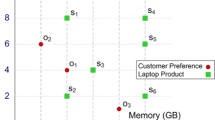Abstract
Given a set S of sites and a set O of weighted objects, an optimal location query finds the location(s) where introducing a new site maximizes the total weight of the objects that are closer to the new site than to any other site. With such a query, for instance, a franchise corporation (e.g., McDonald’s) can find a location to open a new store such that the number of potential store customers (i.e., people living close to the store) is maximized. Optimal location queries are computationally complex to compute and require efficient solutions that scale with large datasets. Previously, two specific approaches have been proposed for efficient computation of optimal location queries. However, they both assume p-norm distance (namely, L1 and L2/Euclidean); hence, they are not applicable where sites and objects are located on spatial networks. In this article, we focus on optimal network location (ONL) queries, i.e., optimal location queries in which objects and sites reside on a spatial network. We introduce two complementary approaches, namely EONL (short for Expansion-based ONL) and BONL (short for Bound-based ONL), which enable efficient computation of ONL queries with datasets of uniform and skewed distributions, respectively. Moreover, with an extensive experimental study we verify and compare the efficiency of our proposed approaches with real world datasets, and we demonstrate the importance of considering network distance (rather than p-norm distance) with ONL queries.













Similar content being viewed by others
Notes
There is a user defined parameter called θ𝜖∈ (0,1] used in the FGP-OTF algorithm. For this experiment, we ran the FGP-OTF algorithm with different θ values in the range of [0.0001, 1]. The θ value equal to 0.001 resulted in less computation cost and the corresponding execution time is reported in Fig. 13.
References
Berman O, Krass D (2002) The generalized maximal covering location problems. Comput Oper Res 29(6):563–581
Church RL (1984) The planar maximal covering location problem. J Reg Sci 24(1984):185–201
Church RL, Revelle C (1974) The maximal covering location problem. Pap Reg Sci Assoc 32(1974):101–118
Dijkstra EW (1959) A note on two problems in connection with graphs. Numeriche Math 1(1):269–271
Du Y, Zhang D, Xia T (2005) The optimal-location query. SSTD 2005:163–180
Ghaemi P, Shahabi K, Wilson JP, Banaei-Kashani F (2010) Optimal network location queries. Proceedings of the 18th SIGSPATIAL international conference on advances in geographic. Inf Syst 2010:478–481
Goldberg AV, Harrelson C (2005) Computing the shortest path: a* search meets graph theory. ACM-SIAM 2005:156–165
Korn F, Muthukrishnan S (2000) Influence sets based on reverse nearest neighbor queries. SIGMOD 29(2):201–212
Mehrez A, Stulman A (1982) The maximal covering location problem with facility placement on the entire plane. J Reg Sci 22(1982):361–365
Murray AT, Tong D (2007) Coverage optimization in continuous space facility siting. Int J Geogr Inf Sci 21(7):757–776
Papadias D, Zhang J, Mamoulis N, Tao Y (2003) Query processing in spatial network databases. VLDB 2003:802–813
Stanoi I, Riedwald M, El Abbadi A (2001) Discovery of influence sets in frequently updated databases. VLDB 2001:99–108
Toregas C, Swain R, Revelle C (1971) Bergman L (1971) The location of emergency service facilities. Oper Res 19(6):1363–1373
Wong RC, Ozsu MT, Yu PS, Fu AW, Liu L (2009) Efficient method for maximizing bichromatic reverse nearest neighbor. VLDB 2009:1126–1149
Xia T, Zhang D, Kanoulas E, Du Y (2005) On computing top-t most influential spatial sites. VLDB 2005:946–957
Xiao X, Yao B, Li F (2011) Optimal location queries in road network databases. Proceedings 27th ICDE Conference, 2011
Yang C, Lin KI (2001) An index structure for efficient reverse nearest neighbor queries. ICDE 2001:51–60
Acknowledgments
The authors would like to thank Professor FeiFei Li for making the source code and the corresponding datasets used in [16] accessible.
Author information
Authors and Affiliations
Corresponding author
Rights and permissions
About this article
Cite this article
Ghaemi, P., Shahabi, K., Wilson, J.P. et al. A comparative study of two approaches for supporting optimal network location queries. Geoinformatica 18, 229–251 (2014). https://doi.org/10.1007/s10707-013-0179-x
Received:
Revised:
Accepted:
Published:
Issue Date:
DOI: https://doi.org/10.1007/s10707-013-0179-x




